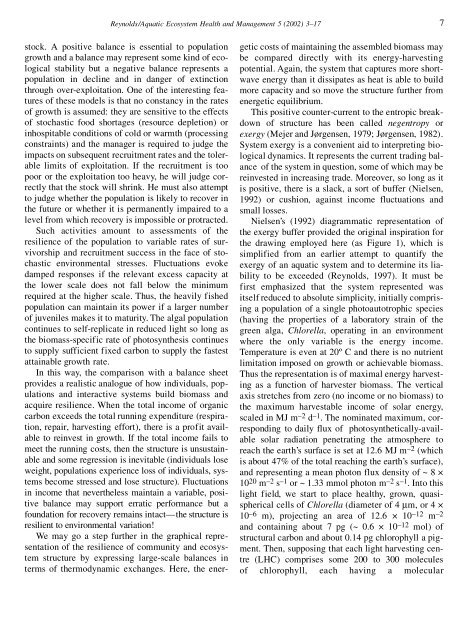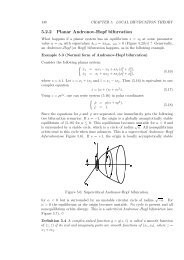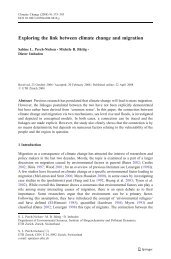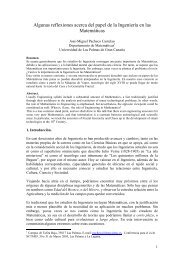Resilience in aquatic ecosystems - hysteresis, homeostasis, and ...
Resilience in aquatic ecosystems - hysteresis, homeostasis, and ...
Resilience in aquatic ecosystems - hysteresis, homeostasis, and ...
Create successful ePaper yourself
Turn your PDF publications into a flip-book with our unique Google optimized e-Paper software.
Reynolds/Aquatic Ecosystem Health <strong>and</strong> Management 5 (2002) 3–17 7<br />
stock. A positive balance is essential to population<br />
growth <strong>and</strong> a balance may represent some k<strong>in</strong>d of ecological<br />
stability but a negative balance represents a<br />
population <strong>in</strong> decl<strong>in</strong>e <strong>and</strong> <strong>in</strong> danger of ext<strong>in</strong>ction<br />
through over-exploitation. One of the <strong>in</strong>terest<strong>in</strong>g features<br />
of these models is that no constancy <strong>in</strong> the rates<br />
of growth is assumed: they are sensitive to the effects<br />
of stochastic food shortages (resource depletion) or<br />
<strong>in</strong>hospitable conditions of cold or warmth (process<strong>in</strong>g<br />
constra<strong>in</strong>ts) <strong>and</strong> the manager is required to judge the<br />
impacts on subsequent recruitment rates <strong>and</strong> the tolerable<br />
limits of exploitation. If the recruitment is too<br />
poor or the exploitation too heavy, he will judge correctly<br />
that the stock will shr<strong>in</strong>k. He must also attempt<br />
to judge whether the population is likely to recover <strong>in</strong><br />
the future or whether it is permanently impaired to a<br />
level from which recovery is impossible or protracted.<br />
Such activities amount to assessments of the<br />
resilience of the population to variable rates of survivorship<br />
<strong>and</strong> recruitment success <strong>in</strong> the face of stochastic<br />
environmental stresses. Fluctuations evoke<br />
damped responses if the relevant excess capacity at<br />
the lower scale does not fall below the m<strong>in</strong>imum<br />
required at the higher scale. Thus, the heavily fished<br />
population can ma<strong>in</strong>ta<strong>in</strong> its power if a larger number<br />
of juveniles makes it to maturity. The algal population<br />
cont<strong>in</strong>ues to self-replicate <strong>in</strong> reduced light so long as<br />
the biomass-specific rate of photosynthesis cont<strong>in</strong>ues<br />
to supply sufficient fixed carbon to supply the fastest<br />
atta<strong>in</strong>able growth rate.<br />
In this way, the comparison with a balance sheet<br />
provides a realistic analogue of how <strong>in</strong>dividuals, populations<br />
<strong>and</strong> <strong>in</strong>teractive systems build biomass <strong>and</strong><br />
acquire resilience. When the total <strong>in</strong>come of organic<br />
carbon exceeds the total runn<strong>in</strong>g expenditure (respiration,<br />
repair, harvest<strong>in</strong>g effort), there is a profit available<br />
to re<strong>in</strong>vest <strong>in</strong> growth. If the total <strong>in</strong>come fails to<br />
meet the runn<strong>in</strong>g costs, then the structure is unsusta<strong>in</strong>able<br />
<strong>and</strong> some regression is <strong>in</strong>evitable (<strong>in</strong>dividuals lose<br />
weight, populations experience loss of <strong>in</strong>dividuals, systems<br />
become stressed <strong>and</strong> lose structure). Fluctuations<br />
<strong>in</strong> <strong>in</strong>come that nevertheless ma<strong>in</strong>ta<strong>in</strong> a variable, positive<br />
balance may support erratic performance but a<br />
foundation for recovery rema<strong>in</strong>s <strong>in</strong>tact—the structure is<br />
resilient to environmental variation!<br />
We may go a step further <strong>in</strong> the graphical representation<br />
of the resilience of community <strong>and</strong> ecosystem<br />
structure by express<strong>in</strong>g large-scale balances <strong>in</strong><br />
terms of thermodynamic exchanges. Here, the energetic<br />
costs of ma<strong>in</strong>ta<strong>in</strong><strong>in</strong>g the assembled biomass may<br />
be compared directly with its energy-harvest<strong>in</strong>g<br />
potential. Aga<strong>in</strong>, the system that captures more shortwave<br />
energy than it dissipates as heat is able to build<br />
more capacity <strong>and</strong> so move the structure further from<br />
energetic equilibrium.<br />
This positive counter-current to the entropic breakdown<br />
of structure has been called negentropy or<br />
exergy (Mejer <strong>and</strong> Jørgensen, 1979; Jørgensen, 1982).<br />
System exergy is a convenient aid to <strong>in</strong>terpret<strong>in</strong>g biological<br />
dynamics. It represents the current trad<strong>in</strong>g balance<br />
of the system <strong>in</strong> question, some of which may be<br />
re<strong>in</strong>vested <strong>in</strong> <strong>in</strong>creas<strong>in</strong>g trade. Moreover, so long as it<br />
is positive, there is a slack, a sort of buffer (Nielsen,<br />
1992) or cushion, aga<strong>in</strong>st <strong>in</strong>come fluctuations <strong>and</strong><br />
small losses.<br />
Nielsen’s (1992) diagrammatic representation of<br />
the exergy buffer provided the orig<strong>in</strong>al <strong>in</strong>spiration for<br />
the draw<strong>in</strong>g employed here (as Figure 1), which is<br />
simplified from an earlier attempt to quantify the<br />
exergy of an <strong>aquatic</strong> system <strong>and</strong> to determ<strong>in</strong>e its liability<br />
to be exceeded (Reynolds, 1997). It must be<br />
first emphasized that the system represented was<br />
itself reduced to absolute simplicity, <strong>in</strong>itially compris<strong>in</strong>g<br />
a population of a s<strong>in</strong>gle photoautotrophic species<br />
(hav<strong>in</strong>g the properties of a laboratory stra<strong>in</strong> of the<br />
green alga, Chlorella, operat<strong>in</strong>g <strong>in</strong> an environment<br />
where the only variable is the energy <strong>in</strong>come.<br />
Temperature is even at 20º C <strong>and</strong> there is no nutrient<br />
limitation imposed on growth or achievable biomass.<br />
Thus the representation is of maximal energy harvest<strong>in</strong>g<br />
as a function of harvester biomass. The vertical<br />
axis stretches from zero (no <strong>in</strong>come or no biomass) to<br />
the maximum harvestable <strong>in</strong>come of solar energy,<br />
scaled <strong>in</strong> MJ m –2 d –1 . The nom<strong>in</strong>ated maximum, correspond<strong>in</strong>g<br />
to daily flux of photosynthetically-available<br />
solar radiation penetrat<strong>in</strong>g the atmosphere to<br />
reach the earth’s surface is set at 12.6 MJ m –2 (which<br />
is about 47% of the total reach<strong>in</strong>g the earth’s surface),<br />
<strong>and</strong> represent<strong>in</strong>g a mean photon flux density of ~ 8 ×<br />
10 20 m –2 s –1 or ~ 1.33 mmol photon m –2 s –1 . Into this<br />
light field, we start to place healthy, grown, quasispherical<br />
cells of Chlorella (diameter of 4 mm, or 4 ×<br />
10 –6 m), project<strong>in</strong>g an area of 12.6 × 10 –12 m –2<br />
<strong>and</strong> conta<strong>in</strong><strong>in</strong>g about 7 pg (~ 0.6 × 10 –12 mol) of<br />
structural carbon <strong>and</strong> about 0.14 pg chlorophyll a pigment.<br />
Then, suppos<strong>in</strong>g that each light harvest<strong>in</strong>g centre<br />
(LHC) comprises some 200 to 300 molecules<br />
of chlorophyll, each hav<strong>in</strong>g a molecular






